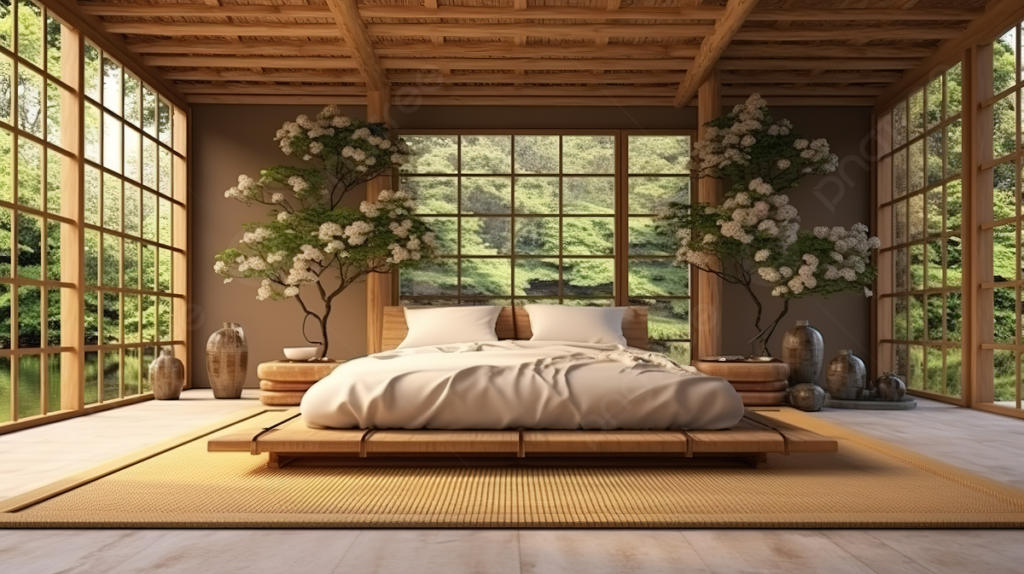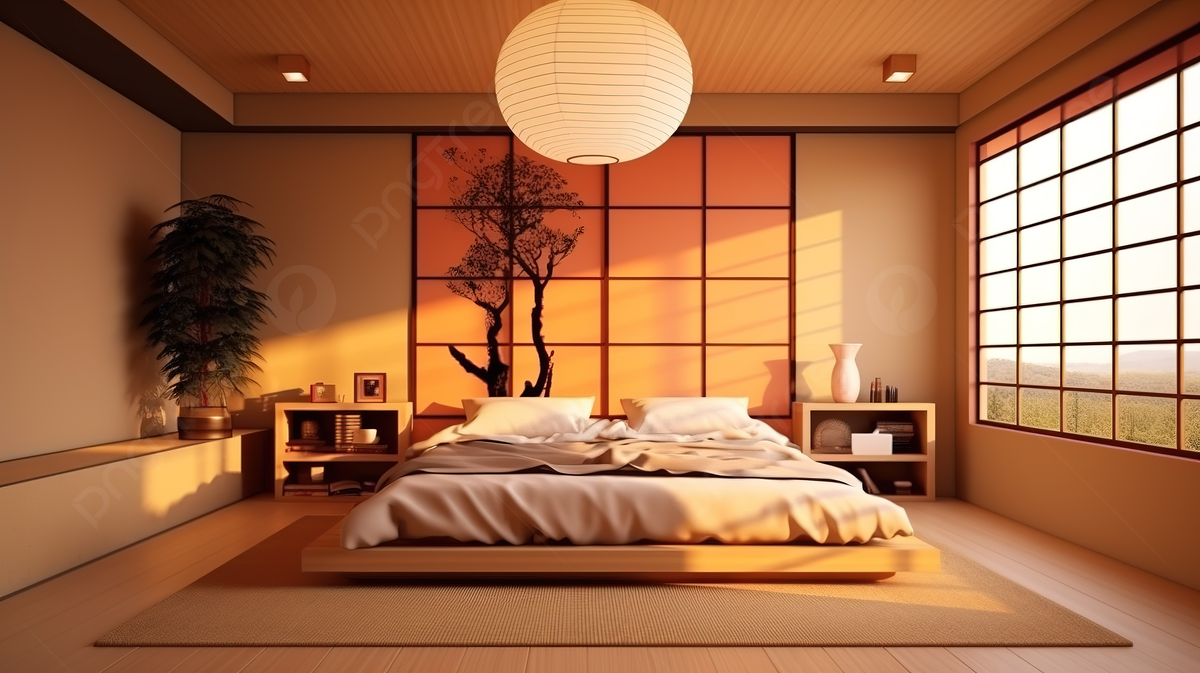Traditional Japanese bedroom design aesthetics originate from reverence for nature, simplicity of line and form, and the concept of restorative environments, a concept precisely opposite to ornamentation. Traditional Japanese interior design is famous for its oxbow and natural accents; it has some elements that can easily be incorporated into any bedroom. The following article will discuss those factors and offer advice on how to design a calming space reminiscent of Japan.
Mats

The choice of tatami flooring can change the look of a bedroom and bring a piece of Japanese culture into the room, making it cozier. The contemporary tatami mats are made with rice straws and rush grass giving them a look at the actuality of Japanese tradition. In addition to being aesthetically pleasing, tatami floors are also soft to the feet and make walking, sitting, or sleeping comfortable and healthful. The smell of rush grass is also soft and adds yet another layer to the stimulation providing a scent that helps to calm the atmosphere of the room. To give a particular home comfort and make it as warm as possible with the help of embracing tatami flooring is to choose the Japanese style as a kind of timeless beauty and comfort.
Also, tatami mats are light tan, and to some extent, they lend a good look to the overall design of a Japanese-style bedroom.
Color Scheme
Japanese interior design emphasizes the use of color. When designing a bedroom in this style using natural colors and natural materials is recommended.
Neutral colors like beige, cream, and taupe are also good for the body and spirit. Small highlights of color that would be incorporated can be soft pinks from cherry blossoms or deep indigo.
The complexion also needs to be well-balanced and integrated into the selected course of colors. This helps to eliminate over-encompassing combinations, making sure that the room stays a comfortable and calming sanctuary.
Analysis of Natural Light and Its Significance
There is no better source of light than natural in the Japanese design. It brings serenity and relates the room with the exterior environment.
When designing a Zen bedroom, the main idea is to let as much natural light into the room as possible. Choose between sheer curtains or blinds where they can allow light into the room but at the same time privacy.
Place the bed and furniture in such a way that light falls properly to light up the room.
If natural light is a problem, install some low-wattage, warm light bulbs that give the impression of sunlight. This will assist in making the environment as warm as possible.
Shoji Screens

Shoji screens can enhance the beauty of your bedroom and also be useful in the room. The old-style Japanese room separators provide privacy and allow for the entrance of gentle light.
Constructed with paper divisions set within wooden borders, Shoji screens provide light to the room while not compromising the privacy of the space. They contribute to the development of zones for sleeping dressing or meditating, yet maintaining an open concept.
The illumination from the paper panels makes the environment to be so comfortable for resting and relaxing. Shoji screens can play an important role both in the aesthetics and utility of your bedroom.
Choosing a Japanese Futon Bed

A futon bed in Japanese traditional style is a very basic and suitable type of bed to sleep on. Futons go well with a mattress placed directly on the floor: again, simplicity and love for nature are present in Japanese culture.
The low design keeps you feeling close to the earth and grounded so that you have a secure feeling as you sleep. Because futon mattresses are foldable and adjustable, they provide good support to your body hence giving you a good sleep.
Japanese futon bed – deciding for it brings functionality and minimalism into a bedroom, which is associated with relaxation.
Fusuma Sliding Doors and its Integration

Fusuma sliding doors are a part of the traditional Japanese style that, when incorporated into your bedroom design, will help to save space. These beauty doors are typically constructed from paper-veneered wooden frames, which makes them beautiful and practical.
Fusuma doors are moving along tracks, and it is rather easy to change the position of the door, so the room can be divided in a number of ways, which can be helpful to use the space as effectively as possible. This makes them ideal for small bedrooms or those who love simple and clean designs.
The paper panels allow only a smooth and filtered kind of light that gives a relaxing and soothing environment. The installation of Fusuma sliding doors brings a sense of classical elegance to the room and increases the possibilities of the bedroom design.
Zen Garden Elements Implementation

Proper decoration of the bedroom can be done by incorporating things such as stones, sand, and plants that are used in the construction of Zen gardens. These natural features link indoors with nature which will assist in making your room a haven.
Stack the stones neatly or put them strategically in a room for a tranquility effect. A small sand garden or tray at home can be an exquisite ornament and a call for contemplation.
Placing flower pots or bonsai trees makes a difference to the area and improves the natural theme. That is why by adding these elements from the Zen garden, you make your bedroom quiet and comfortable, giving your soul a chance to rest.
Hanging Paper Lanterns

Lighting is important in any room, and including paper lanterns in your Japanese-inspired bedroom will produce that dim light that is perfect for the theme. Formerly known as Japanese nightingales, these are lanterns carved with rice paper and bamboo frames with a faint-light emitting capacity; they warm the room up.
Positioned thoughtfully around the space, paper lanterns help create a serene environment, ideal for unwinding after a long day or setting a relaxing mood. It is true that the simple and stylish look also gives your place a realistic feel as if it has a tranquility that makes a room relaxing and suitable for rest.
Creating a Serene Sanctuary
It is possible to turn your bedroom into a sleep sanctuary by bringing in some simple graphic prints and natural elements of Japanese design. Choose objects that have a calm and rather inoffensive look, for example, easel paintings with infrequent distortions or black and white photographs of nature.
Simplify these artworks, and integrate elements such as the bonsai, the bamboo, or fresh flowers to incorporate nature into your house. That way, by clinching these touches, you cultivate an environment that is restful and harmonious— pulling you into the present moment and away from the noise of life. The beauty of Japanese design should be adopted and your bedroom should be made to be as relaxing as possible.
Feng Shui Principles
Aesthetics and energy distribution, as described in the ancient Chinese practice of Feng Shui, is an essential way of organizing the Japanese bedroom. For instance, it examines how people arrange furniture within a room pertaining to the circulation of “chi” and tries to achieve a harmonious atmosphere.
If you want to improve the atmosphere of the bedroom, it is better to keep the space free from obstacles to the circulation of energy. Place your bed in the corner of the room where there is a wall behind you and the door should be visible. Select accessories that will enhance peace and they include; bamboo, wooden pieces of furniture, and soft fabrics.
Lighting is also important; use low light bulbs such as those of bedside lamps or paper lamps as opposed to bright ones. Feng Shui helps to achieve the desired atmosphere and make the interior as comfortable as possible for a person.
Textiles
Select plain and classy fabrics from natural resources that will create a warm and coarse feel to your Japanese bedroom. Fabrics such as cotton, linen, and silk; help in conditioning the atmosphere to become more relaxing and comfortable by creating a favorable appearance of the room.
The best bedding should also be simple in color and design as is common with most Japanese-designed items. Include soft throw blankets, cushions, and floor mats of natural fiber to offer an extra layer of comfort, and in the process, go green and be mindful.
Incorporation of such textiles allows you to develop a comfortable area to rest and at the same time enhances your bond with nature.
Conclusion
Using these calm Japanese bedroom designs, you are able to create the perfect atmosphere for relaxation and inner harmony. Every idea – from a clean look of the space, the lack of unnecessary details, and natural materials to Japanese motifs – helps to create an environment that will allow you to relax and rest. Learn from the best of Japanese aesthetics and design and turn your bedroom into a haven from the storm that is the rest of the world.
FAQs
How Japanese bedroom design is done according to Feng Shui?
Feng Shui refers to the proper positioning of furniture and ornaments to encourage the circulation of energy in the bedroom.
What should I do to include Zen garden features in my bedroom?
Bring stones, sand, and small plants into the bedroom for they are likely to make the bedroom environment natural and associated with nature.
What is a futon bed and why should one choose a futon bed?
A futon bed is a mattress put on the floor that can be folded and this is ideal for creating a simple and close-to-the-ground atmosphere that makes it easy to have a good sleep.
Hi there, you are here because you want a peaceful bedroom. Don’t worry I’m here to help you out in every aspect to make your bedroom a personal sanctuary.
